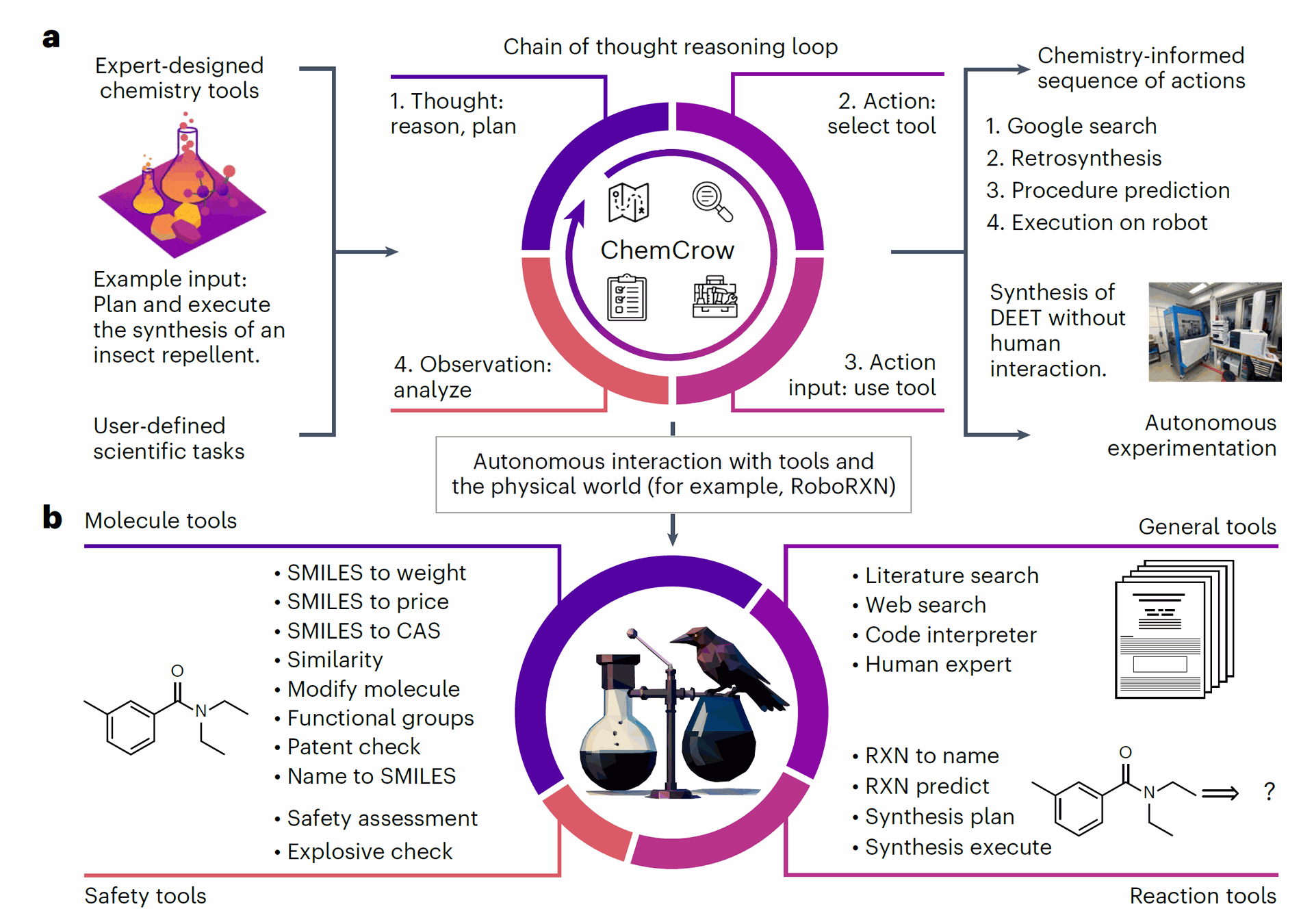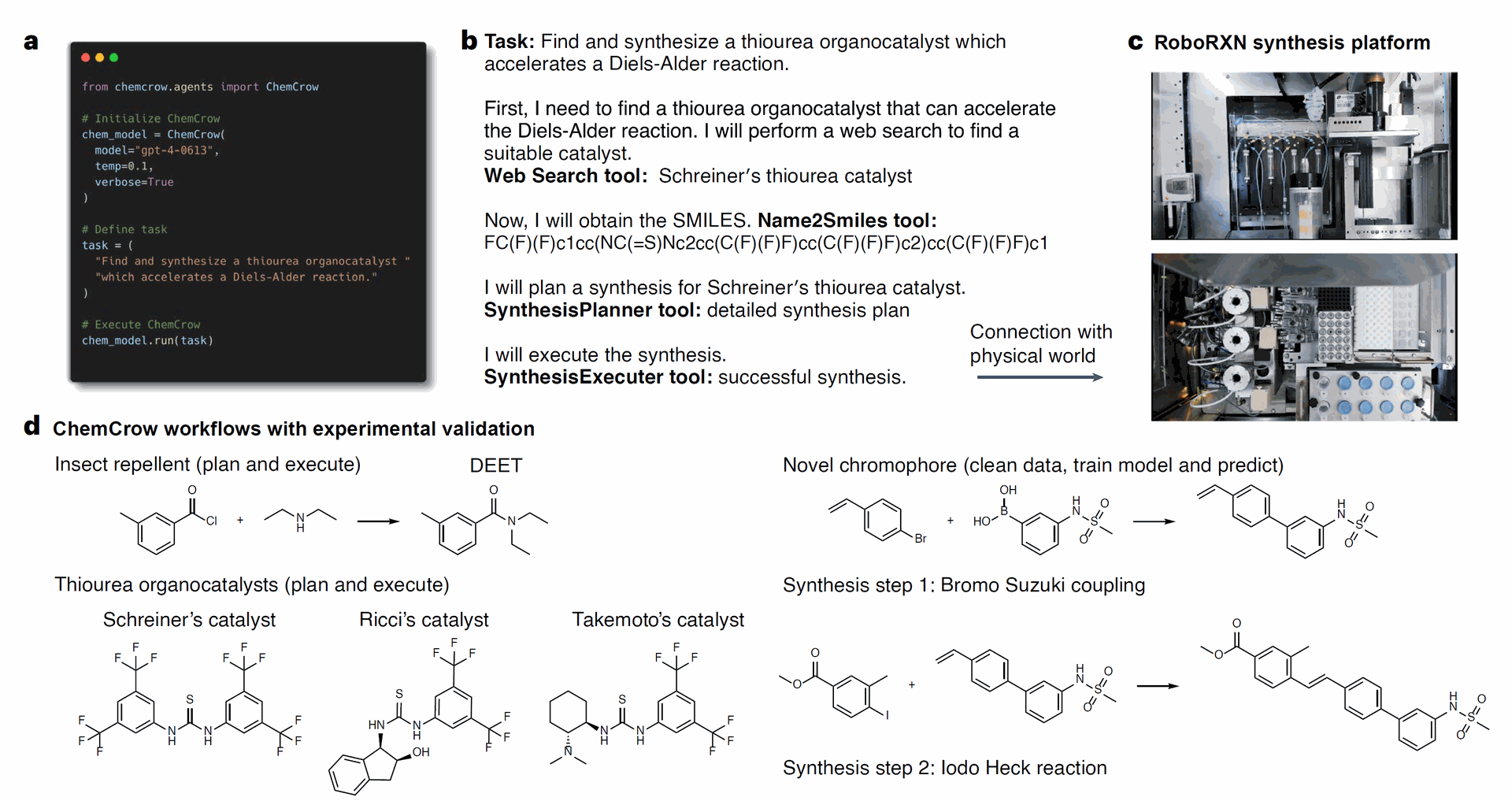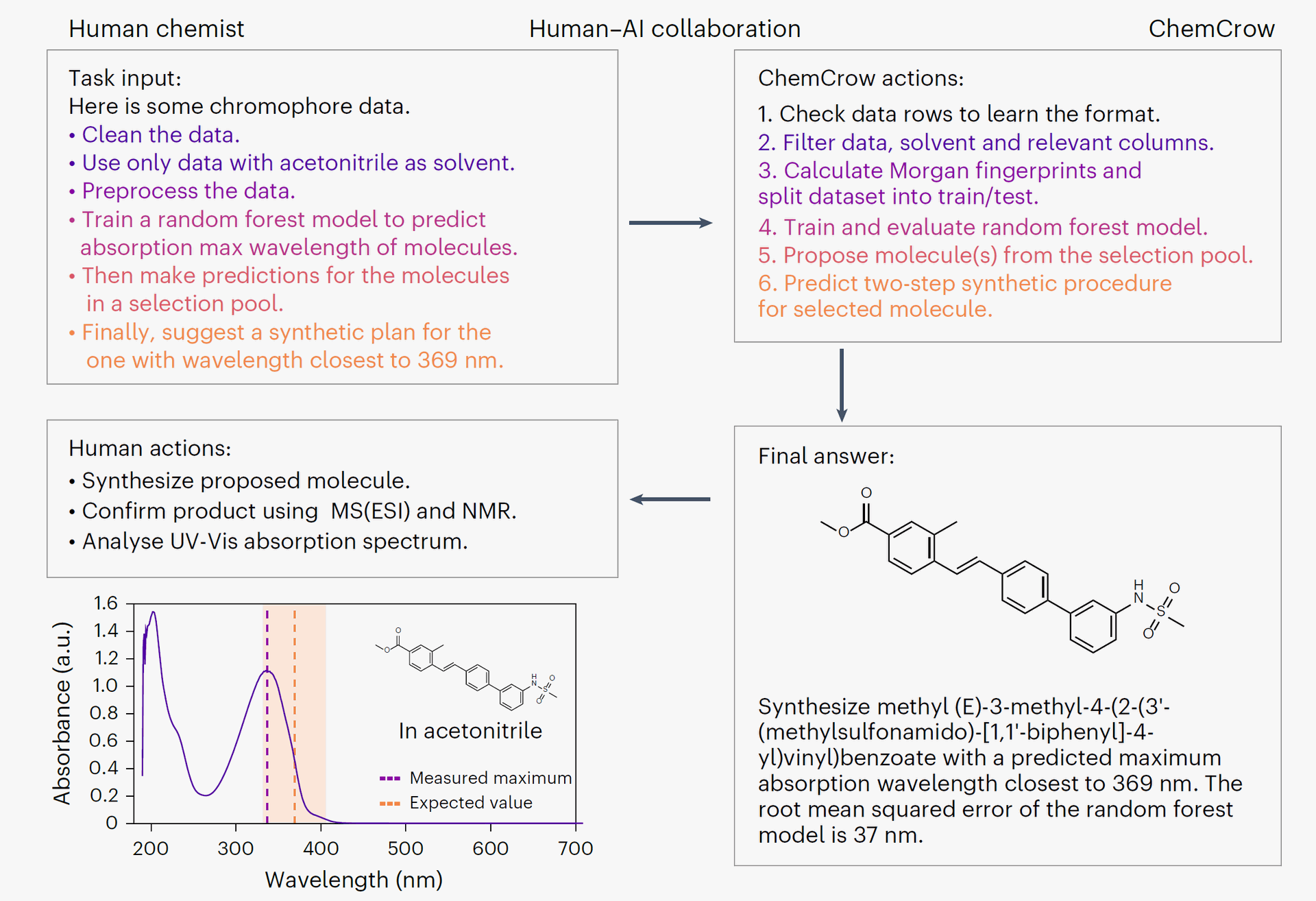This research introduces ChemCrow, an advanced Large Language Model (LLM) integrated with chemistry-specific computational tools designed to enhance the capability of handling complex chemistry tasks, such as organic synthesis, drug discovery, and materials design. ChemCrow demonstrates significant improvements over standalone LLMs by successfully executing chemical syntheses and aiding the discovery of novel chemical compounds.
Key Takeaways
- ChemCrow integrates 18 expert-designed chemistry tools, significantly enhancing the chemistry-related capabilities of GPT-4.
- Successfully autonomously planned and executed syntheses of compounds, including an insect repellent (DEET) and three organo-catalysts.
- Facilitated the discovery of a new chromophore through combined AI and human efforts.
- Built on LangChain allowing additional tool integration
- Outperformed standalone GPT-4 in expert evaluations for accuracy, reasoning, and task completeness.
- Demonstrated potential to bridge the gap between computational and experimental chemistry, making complex tasks accessible to non-experts.

Fig. 1 | Overview and toolset. a, An overview of the task-solving process. Using a variety of chemistry-related packages and software, a set of tools is created. These tools and a user input are then given to an LLM. The LLM proceeds through an automatic, iterative chain-of-thought process, deciding on its path, choice of tools and inputs before coming to a final answer. The example shows the synthesis of DEET, a common insect repellent. b, Toolsets implemented in ChemCrow: reaction, molecule, safety, search and standard tools. Credit:
photograph in a, IBM Research under a creative commons license
Overview
ChemCrow addresses a critical limitation in existing LLMs, which typically struggle with specialized scientific fields such as chemistry due to their intrinsic design limitations, including difficulties in accurately executing chemical nomenclature and mathematical computations.
By integrating specialized external computational tools like OPSIN for converting chemical names to molecular structures, ChemCrow mitigates these shortcomings. Tools incorporated range from general functionalities such as web search and Python execution environments to chemistry-specific tasks like retrosynthesis prediction and molecular property assessment.
The ChemCrow system, built on LangChain, operates using a 'Thought, Action, Action Input, Observation' loop, facilitating autonomous decision-making and iterative interaction with specialized chemistry tools. It harnesses the power of GPT-4 to reason, plan actions, utilize external tools effectively, and interpret outcomes systematically.

Fig. 2 | Experimental validation. a, Example of the script run by a user to initiate ChemCrow. b, Query and synthesis of a thiourea organocatalyst. c, IBM Research RoboRXN synthesis platform on which the experiments were executed (pictures reprinted courtesy of International Business Machines Corporation). d, Experimentally validated compounds. Credit: photographs in c, IBM Research under a creative commons
Why It’s Important
The development of ChemCrow highlights significant strides toward automation in chemistry, particularly for tasks traditionally reserved for trained chemists due to complexity and safety considerations. It potentially democratizes chemistry research, allowing non-experts to engage effectively with complex chemical tasks while providing expert chemists with a powerful assistant.
Integration with physical robotic platforms, such as IBM's RoboRXN, indicates its capability to bridge digital AI systems with real-world chemistry applications, which can accelerate drug discovery, new material development, and general chemical research.
Summary of Results
ChemCrow was evaluated on 14 use cases, including synthesizing target molecules, safety controls, and searching for molecules with similar modes of action. The evaluation involved both LLM and expert assessments, demonstrating ChemCrow's effectiveness in automating a diverse set of chemical tasks.
The framework was evaluated across multiple complex chemical tasks. Notably, it autonomously synthesized DEET and thiourea organocatalysts (Schreiner’s, Ricci’s, and Takemoto’s catalysts) using IBM’s RoboRXN platform. Additionally, ChemCrow assisted in identifying a new chromophore by employing machine learning models to screen and propose a candidate with the desired absorption wavelength properties, later verified experimentally.
In comparative evaluations involving expert human chemists and EvaluatorGPT (an LLM-based evaluation system), ChemCrow consistently outperformed standalone GPT-4 in chemical accuracy and overall reliability, although EvaluatorGPT showed a bias towards the fluency of GPT-4's responses. Expert evaluations strongly preferred ChemCrow for its chemical accuracy and successful task completion, particularly for novel and complex chemical tasks.

Fig. 3 | Human–model interaction leading to the discovery of a new chromophore. Left, human input, actions and observation. Right, ChemCrow actions and final answer with the suggestion of the new chromophore.
ChemCrow utilizes a variety of tools categorized into general tools, molecule tools, safety tools, and chemical reaction tools:
-
General Tools:
- WebSearch: Queries search engines for relevant information.
- LitSearch: Extracts information from scientific documents.
- Python REPL: Executes Python code for complex tasks.
- Human: Allows direct interaction with users for guidance.
-
Molecule Tools:
- Name2SMILES: Converts molecule names to SMILES strings.
- SMILES2Price: Provides information on the commercial cost of molecules.
- Name2CAS: Determines the CAS number of molecules.
- Similarity: Evaluates structural similarity between molecules.
- ModifyMol: Alters molecules by generating chemical space around them.
- PatentCheck: Checks if a molecule has been patented.
- FuncGroups: Identifies functional groups within molecules.
- SMILES2Weight: Calculates the molecular weight of molecules.
-
Safety Tools:
- ControlledChemicalCheck: Checks molecules against lists of chemical weapons and precursors.
- ExplosiveCheck: Identifies explosive molecules using GHS ratings.
- SafetySummary: Provides a general safety overview for molecules.
-
Chemical Reaction Tools:
- NameRXN: Identifies and classifies chemical reactions.
- ReactionPredict: Predicts chemical reactions and retrosynthesis paths.
- ReactionPlanner: Plans synthetic routes for target molecules.
- ReactionExecute: Executes synthesis of molecules using a robotic chemistry lab platform.
The capabilities of ChemCrow can be further enhanced by incorporating additional tools, such as image-processing and language-based tools. Expanding the evaluation tasks and improving the experimental design will help push the limits of what these systems can achieve.
Conclusion
ChemCrow represents a significant advancement in integrating AI and chemistry, highlighting its potential as an essential tool for chemical synthesis, drug discovery, and materials science. Its ability to autonomously execute chemical syntheses and accurately perform chemical reasoning tasks underscores its utility in both educational and professional chemistry settings.
This innovative integration of specialized tools with LLMs could transform future approaches to chemical experimentation and education, making sophisticated chemical research more accessible and effective.

Empowering LLMs with Tools For Drug Discovery
ChemCrow: Augmenting large-language models with chemistry tools